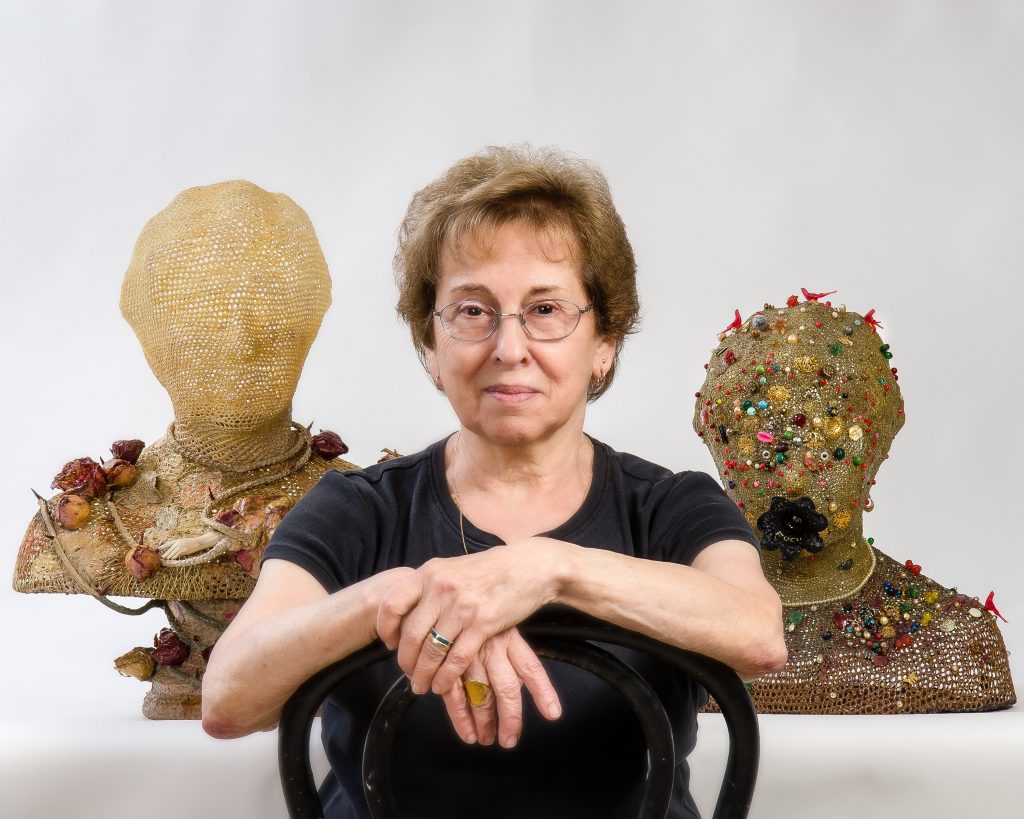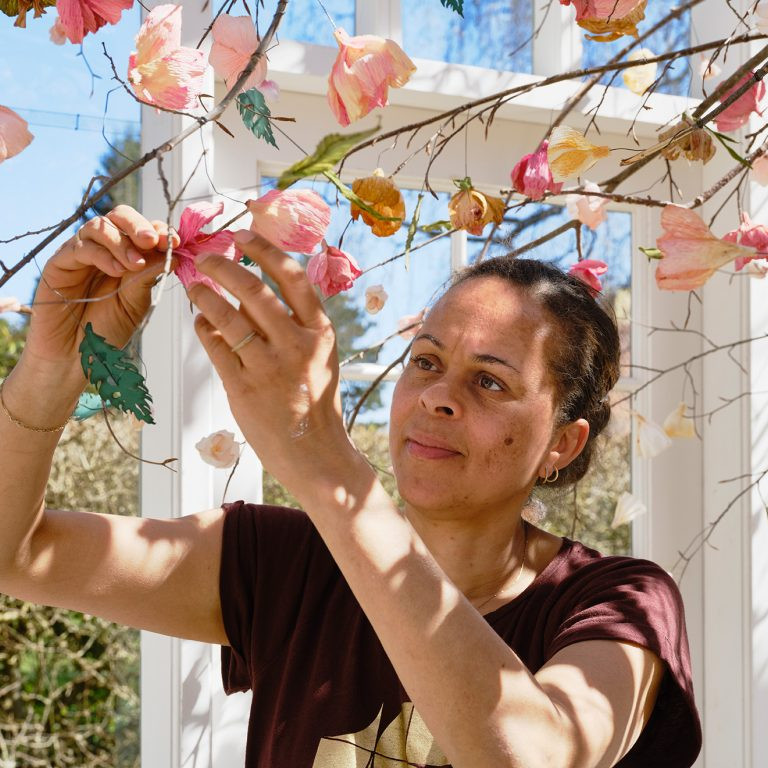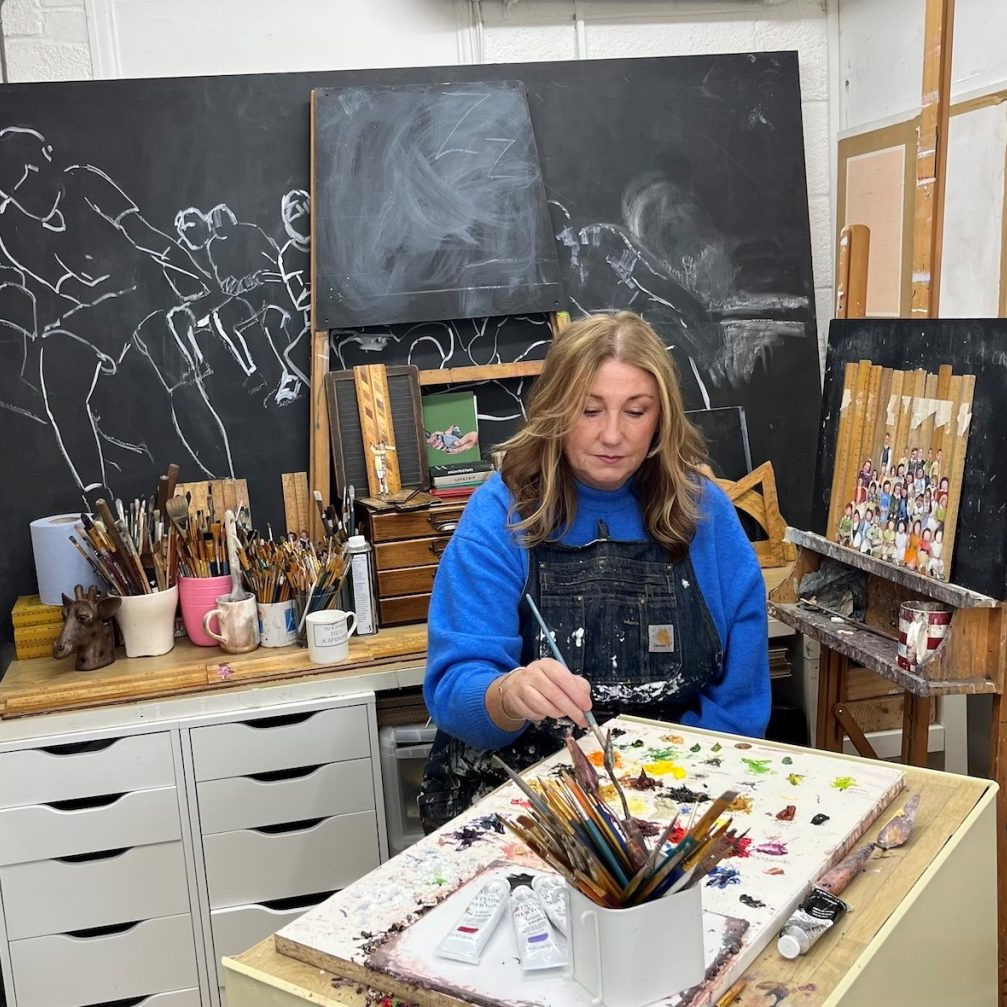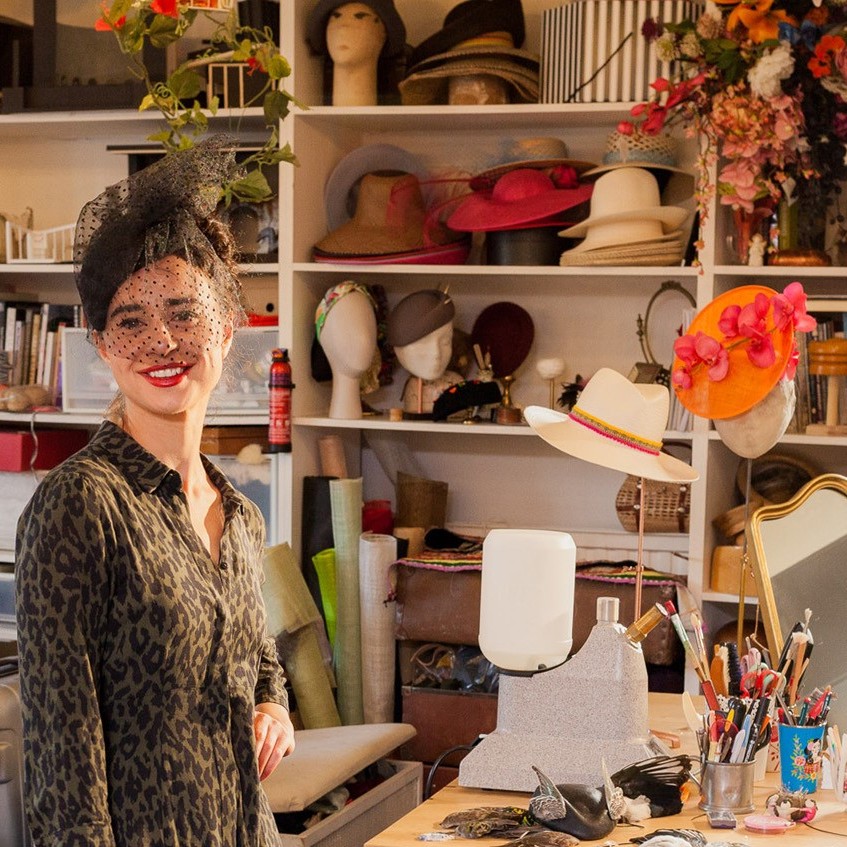Norma Minkowitz Fiber and Mixed Media
So many found objects and textiles, how did this combination come about?
Early on in the 1970’s my work was both knitted and crocheted in opaque solid sculptural forms. When the work became transparent in the 1980’s, I found the addition of found objects to be both provocative and an insight into my imagination, daydreams, thoughts and fears. “Child of The Night” 2008 is such a piece.
 Child of The Night, 2008, 12 x 32 x 22 inches
Child of The Night, 2008, 12 x 32 x 22 inches
It is a dark piece and has a psychological reference to childhood demons. It is about universal themes and in this case suggests (as we have perhaps experienced) a child waking up in the middle of the night and familiar daytime toys become objects of darkness, feeling threatening as the light is no longer visible.
When did your work take on both crochet and found objects?
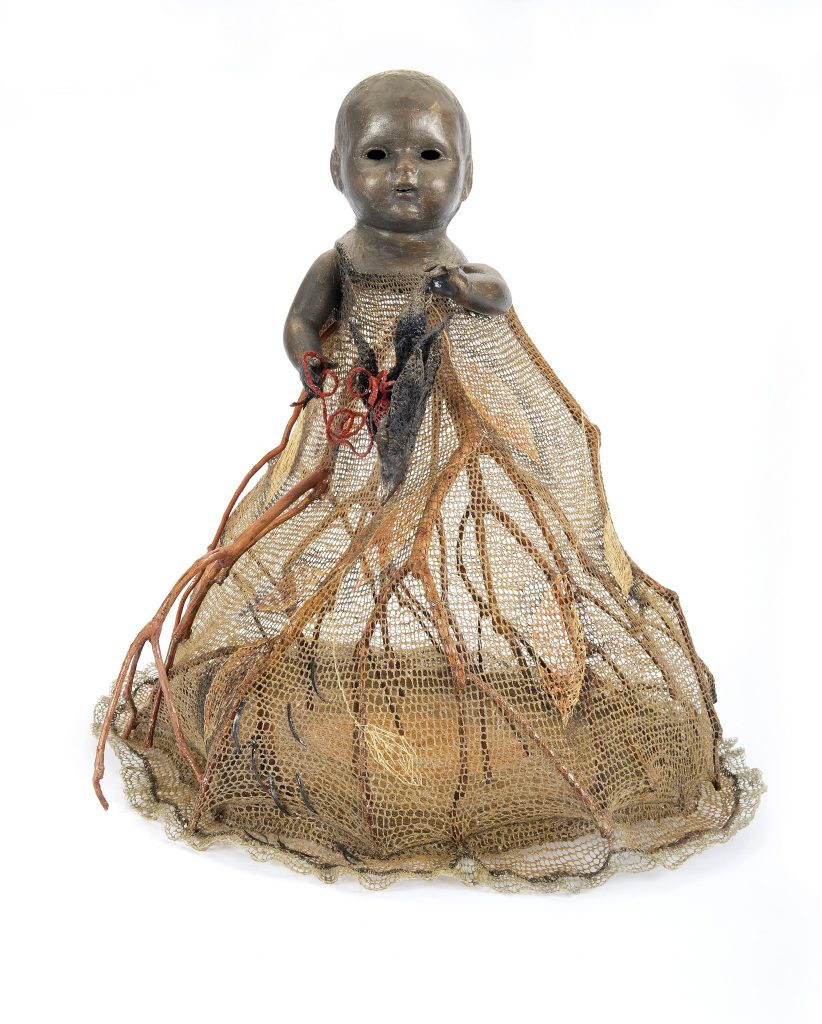 The Present, 2011, 26 x 28 x 27 inches
The Present, 2011, 26 x 28 x 27 inches
In the 1980’s I started experimenting with found objects, many from nature (That were once alive) such as twigs, branches, flowers and leaves. I also used small hardware from metal that was prominent in such sculptures as Excavation.
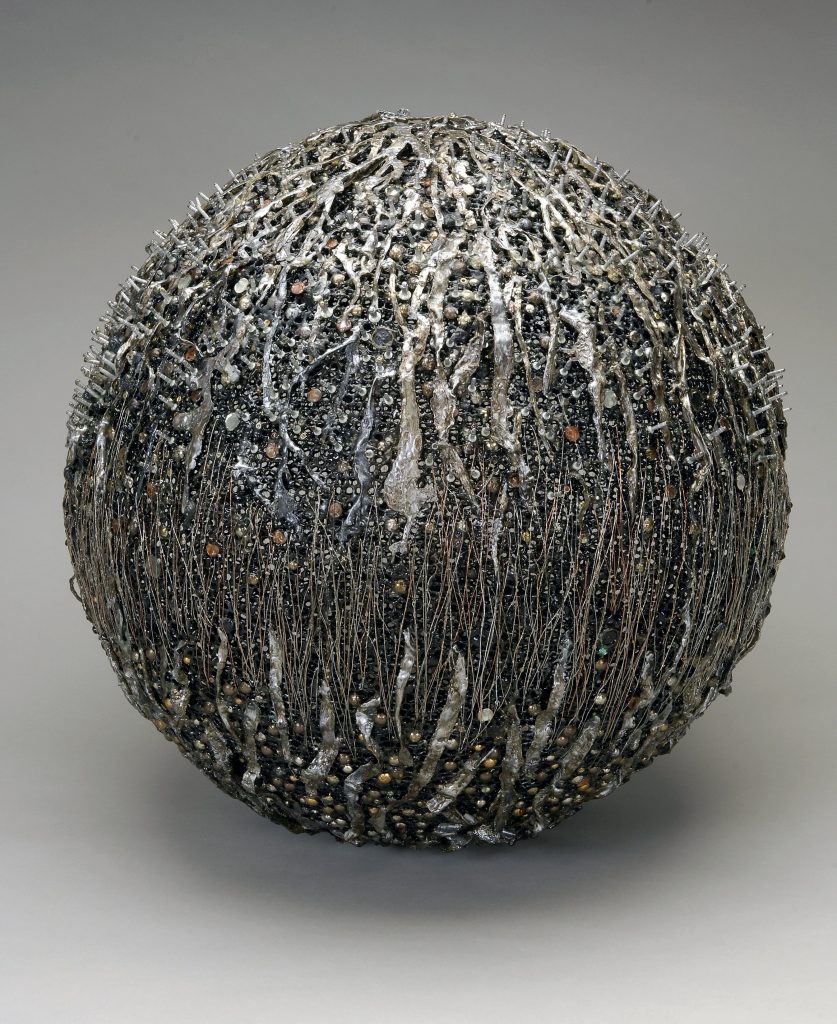
Excavation
From the start of my sculptural work, I always included different textures by stitching, crocheting and knitting. The found objects added another dimension to my work. The base and structural part of my sculptures were always crocheted and stiffened. I also at times used paint directly on the fiber.
How has crochet developed in your work? Take two early pieces to show the early stages of your work.
” Around and A Round” 1974 is an example of mixing crochet with knitting which was a frequent combination of techniques and created varied textures and patterns in my very early works.
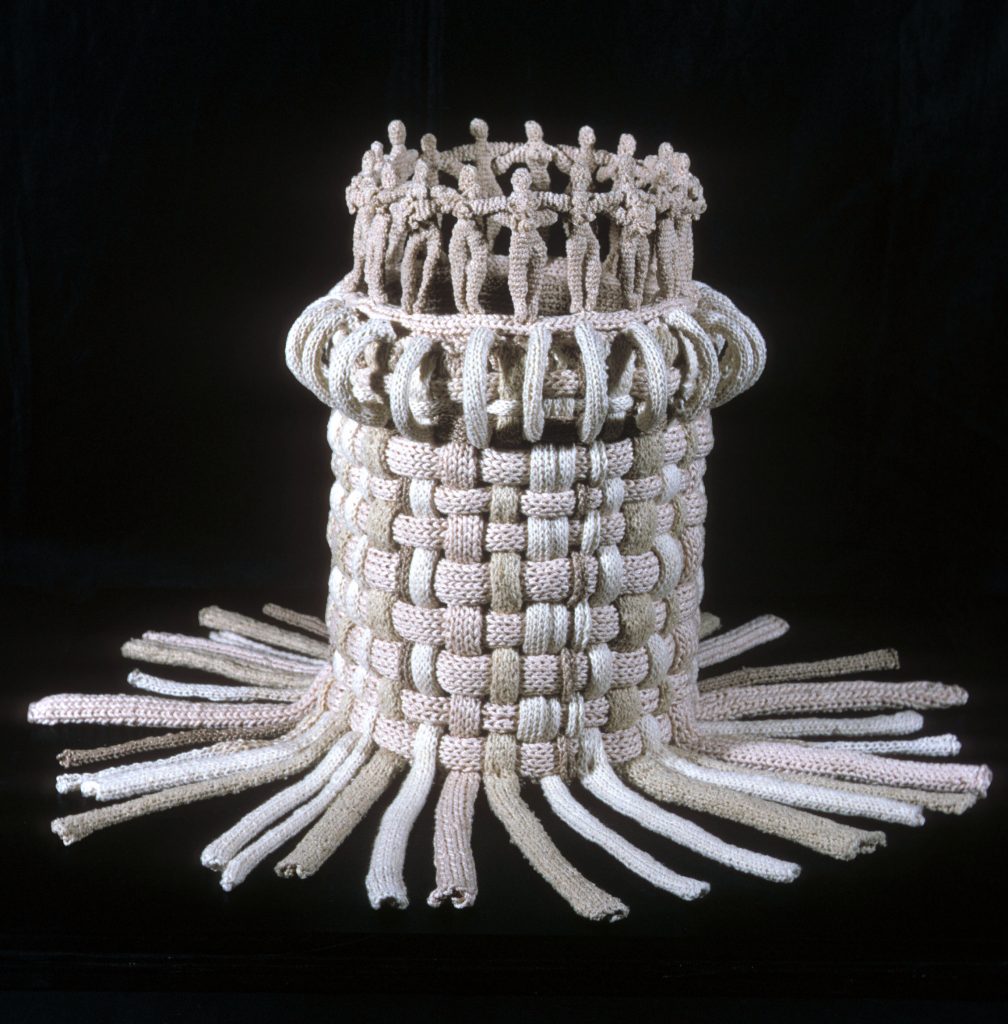
Around and a Round collection of Sandy and Lou Grotta
This experimental solid work was a precursor to my transparent vessel forms as it was both a sculpture also alluded to containment.
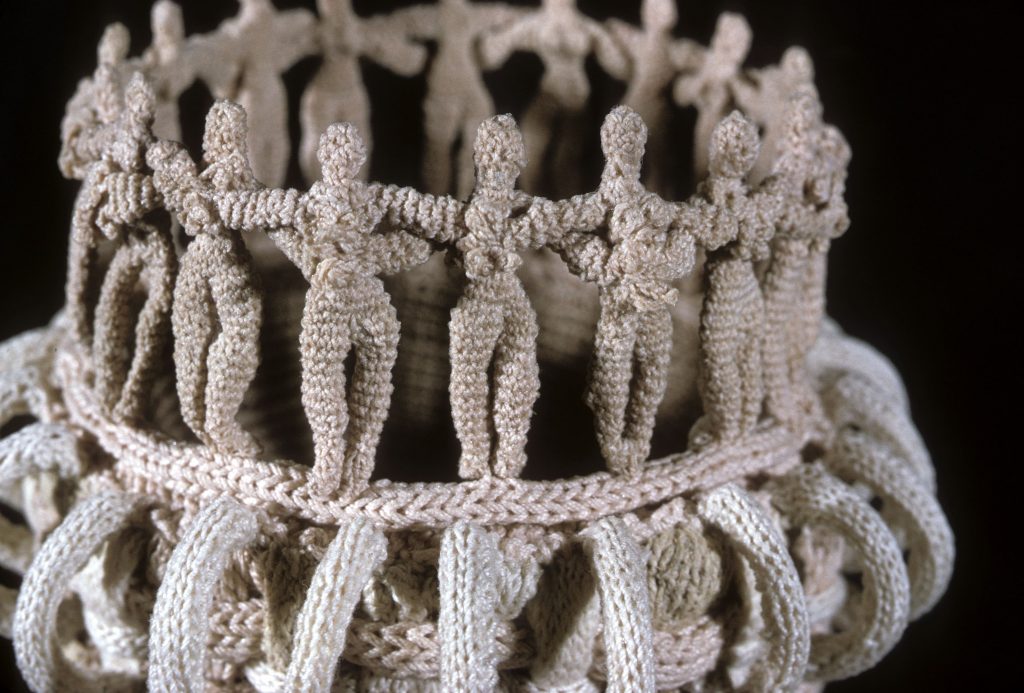
Around and A Round, Around and A Round, 1984, Fibre, detail
This was made before I started stiffening my work, so it needed a structure inside (in this case a coffee can) to keep it upright. The second early piece which is in the Collection of the Denver Art Museum is called “Ghost Rings” 1981.
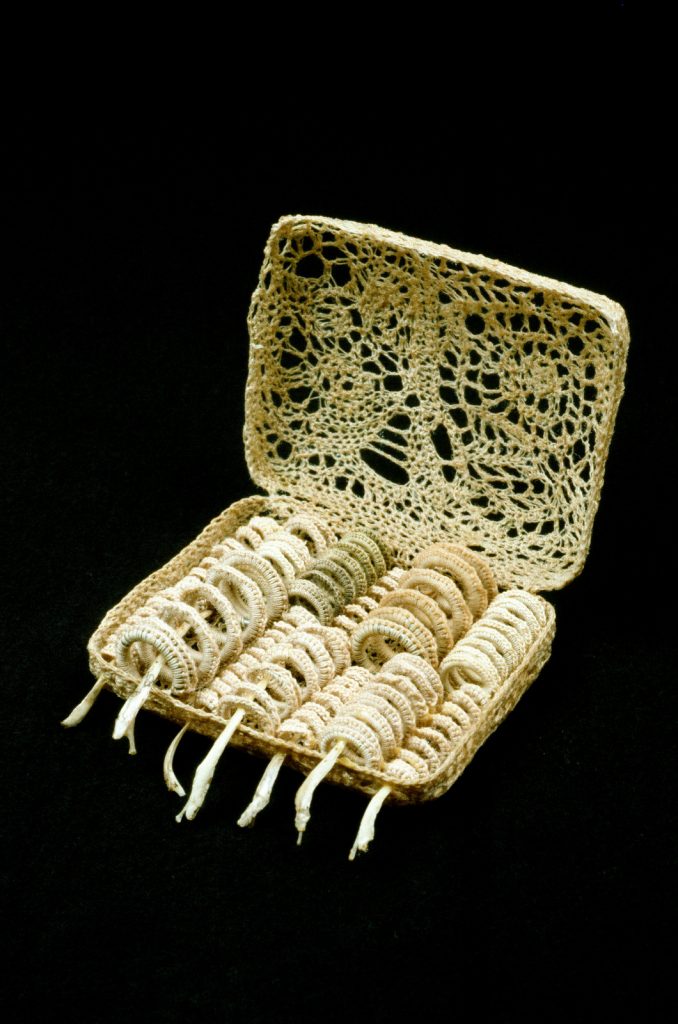
Ghost Rings, 4 x 4 x 3 inches
This was a very small piece, about 4″x 4″x 3″. It was one of the first times I actually crocheted around an object in an open lacey technique, removed the object and had a fragile transparent patterned sculpture. This was a move forward to the vessel forms that followed.
Discuss the importance of transparency in your work.
My work with outer netting creates mystery by obscuring the shape within creating a sense of ambiguity in the shadows of the work. My transparent work conveys a sense of inside and outside, because the transparent mesh walls allow visual access to the interior. Despite the repeated use of the same basic stitch, which to me has a spiritual quality, no two stitches are exactly alike. This conveys the intimacy and imperfection of the human hand and makes the work more powerful.
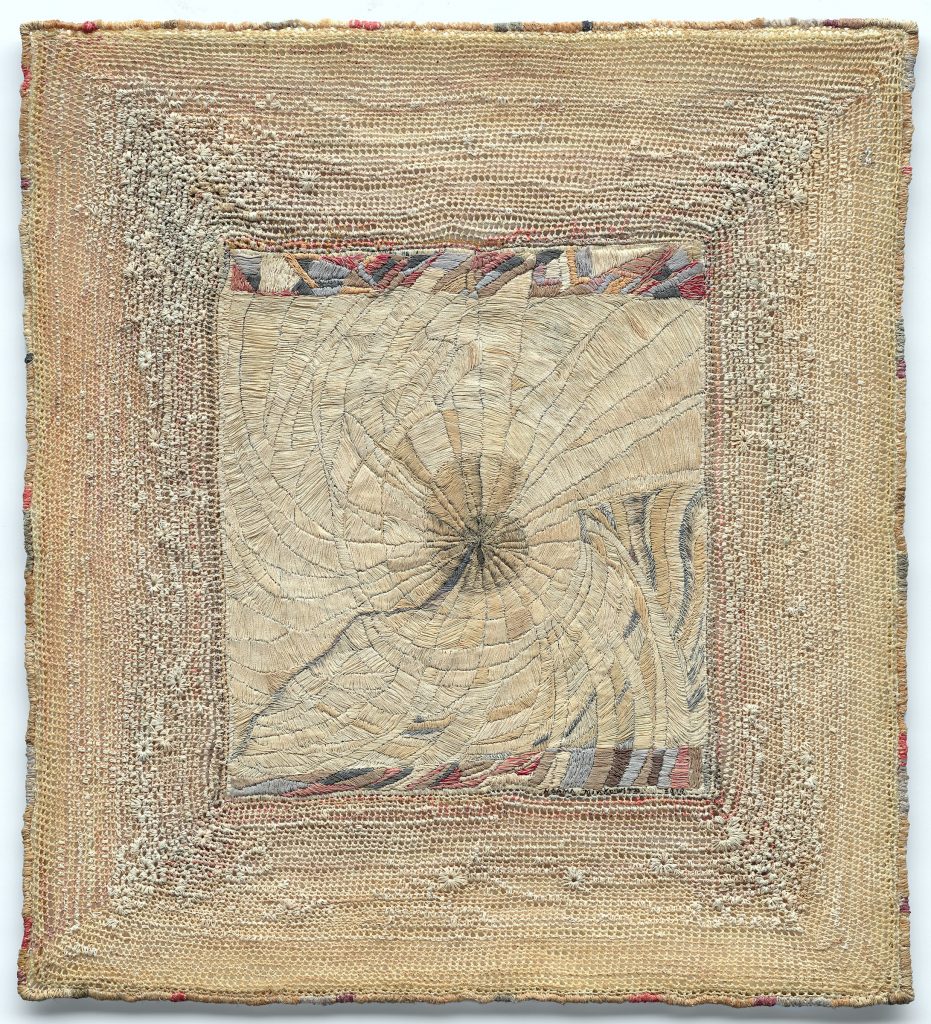
Cyclone Coming, 2019, Stitched and crocheted drawing
I feel the open mesh gives a feeling of ethereal lightness but also implies the concept of containment and psychological complexity. I feel the direction of transparency also related to my interest in developing a personal language as well as connecting to my passion for the drawn line.
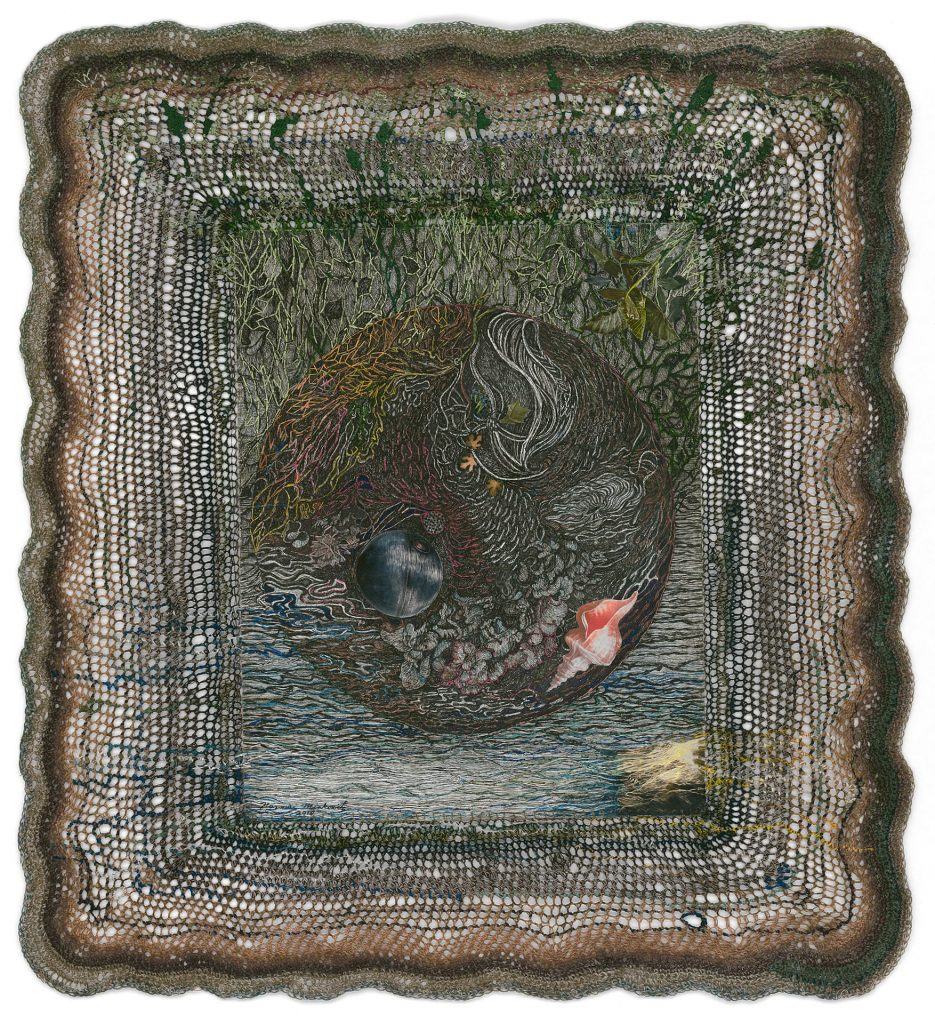
Down the River, 2018, 22 x 21 inches
Take two pieces from your Vessel Forms and briefly explain the techniques you have used and the variations.
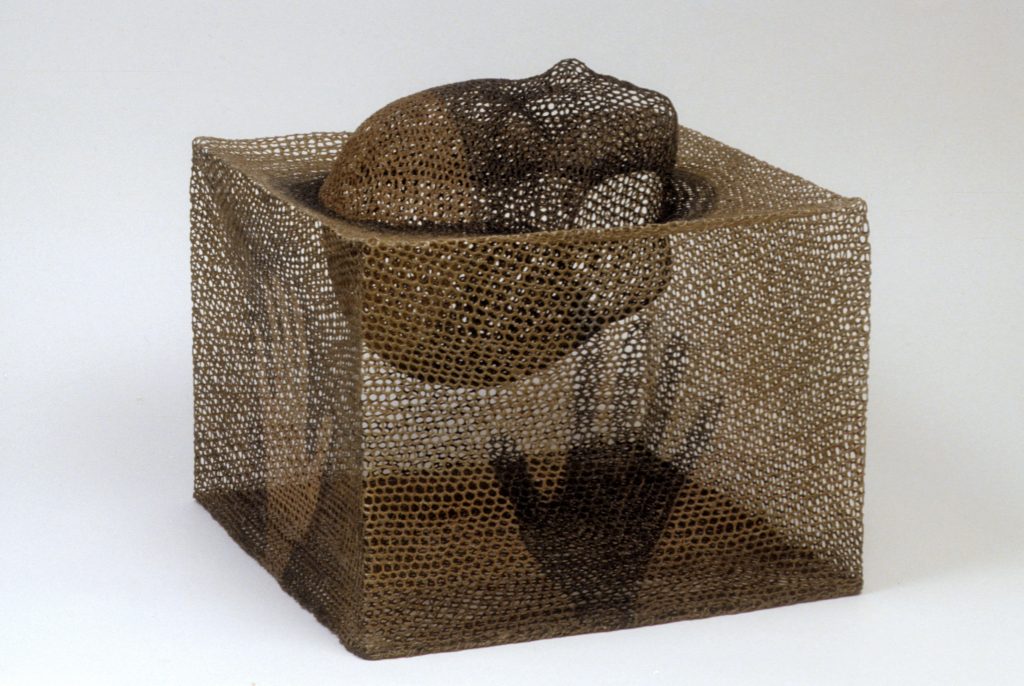
I Can’t Touch You, 1988, Collection of Barry Fisher
” I Can’t Touch You” was created by first making a crocheted head from a casting for the top of the sculpture and as a focal point. When I crochet, I only use one basic stitch as my work is not about different stitches, but the creation of a strong textured surface that is both transparent ,fragile and mysterious. The head I crocheted was supposed to symbolize my mother who had recently passed away. The outside was crocheted over a square form to be the base of the sculpture or perhaps to suggest a coffin also to cradle the head. Each part was stiffened and assembled so that the bottom of the head was visible from both the outside of the box while showing a vision of a submerged head inside of the box. I also painted hands on the outside of the box elucidating the title.
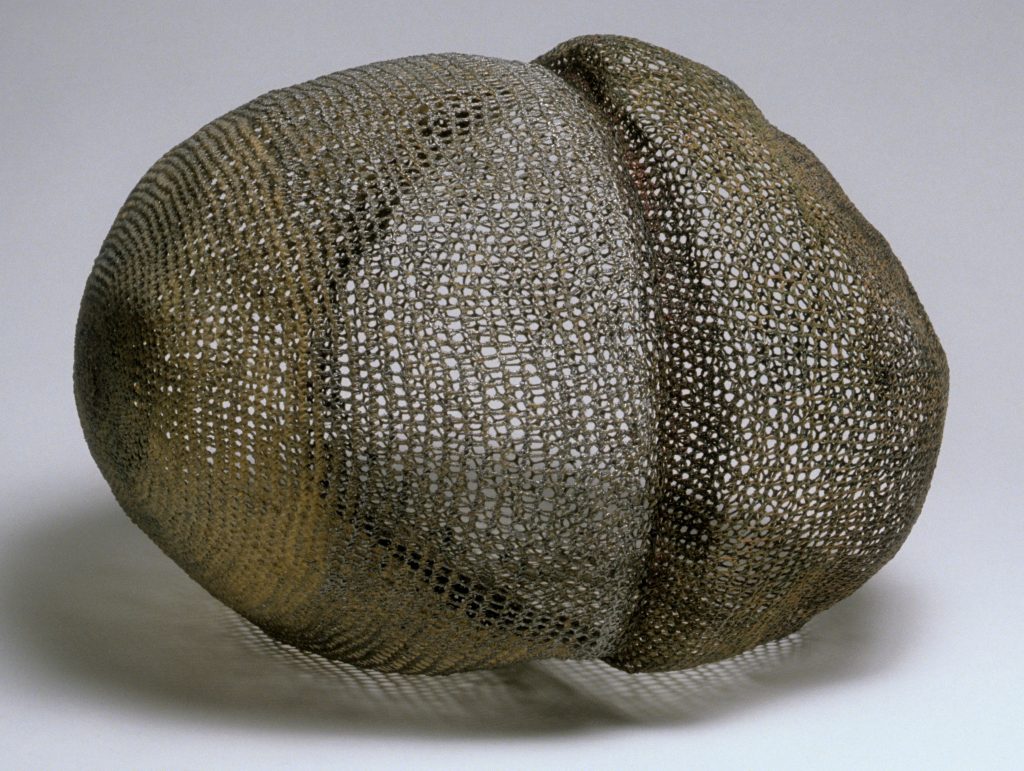
Nucleus, 1990, 12 x 17 x 16 inches
“Nucleus” was a minimal irregular sculpture showing simplicity and variety of textures that showed the interior spaces and the exterior spaces in a overlapping texture that made the piece very interesting and somewhat like my drawings. It was crocheted over rags and fillers, shellacked and then the rags were removed to form the piece.
You comment, “I was drawn to containment, simultaneously, revealing and concealing” discuss.
The notion of containment has been a continuous investigation for me. The concept
of containment motivates personal feelings that I often express in universal themes of earth, life and death. They could suggest the safety of a shelter or a cage from which there is no escape. We see the outside, but also see what is contained within.
The fineness and visual lightness of my linear constructions makes them seem ephemeral; these qualities also relate to my love for pen and ink drawings. These sculptures reveal and conceal at the same time, and the interior often becomes blurred suggesting different stories to the viewer. I encourage the viewer to interpret their own narrative when viewing my work.
What was your first piece to join the collection of a museum?
How did this acquisition propel your career?
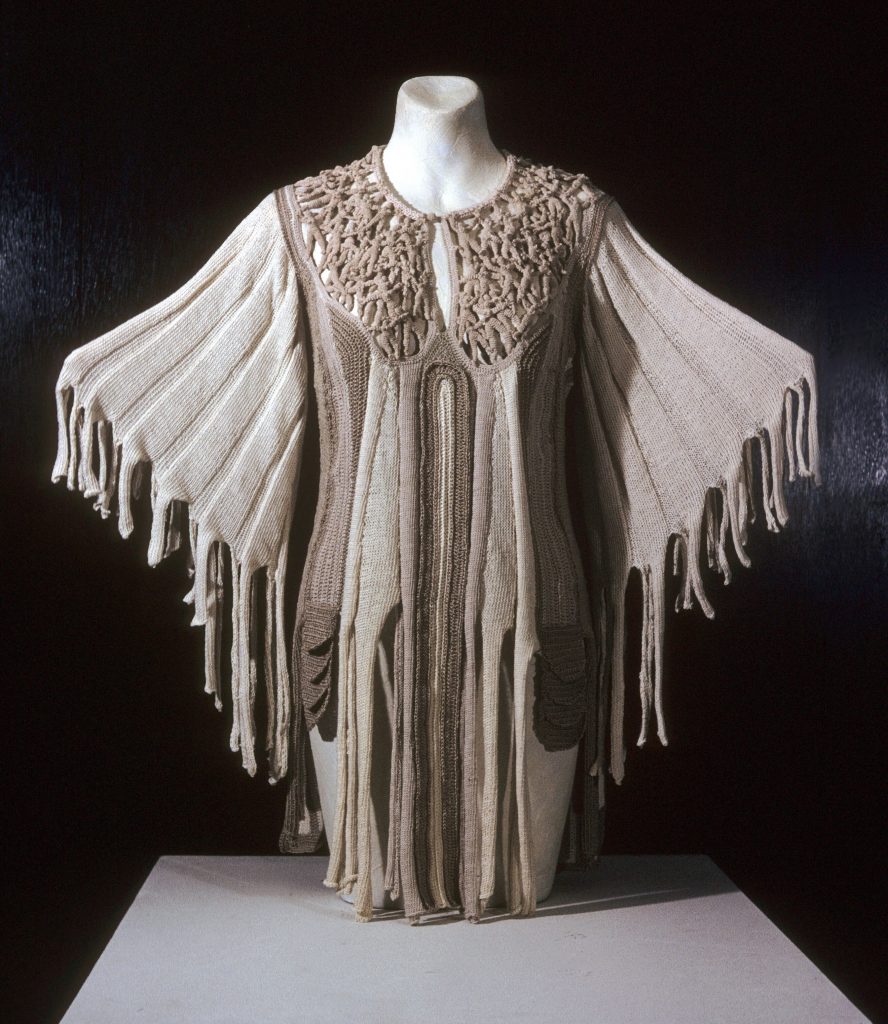
Cloak 1979 collection Metropolitan Museum of Art.
I don’t know exactly which the first piece was as I have 54 artworks in 32 museum collections. One of my first artworks to go to a major Museum was a wearable art piece called “Come Fly with Me”.
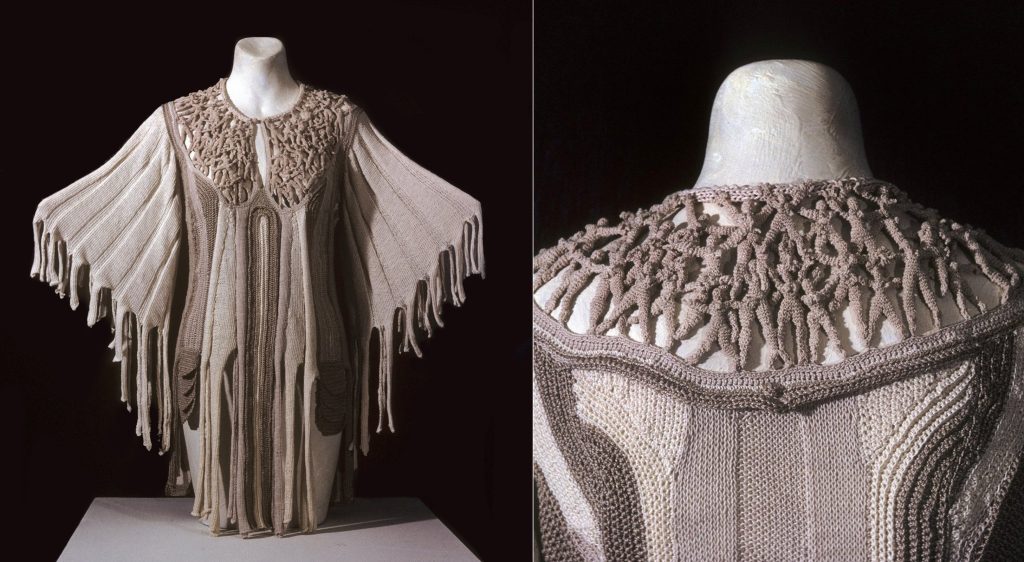
Cloak 1975 Also know as Come Fly with Me, 30″ x 29″- Collection Metropolitan Museum of Art
It went to the Metropolitan Museum of Art in NYC and that was a very important acquisition. I will, however, pick one that was more sculptural and is more indicative of my current work. It was a wall hanging that has made an impact on my career. “Journey’s End”, Is a crocheted and stitched wall drawing with found objects measuring 5′ x 5’x 2″ which was purchased last year by The Minneapolis Institute of Art.
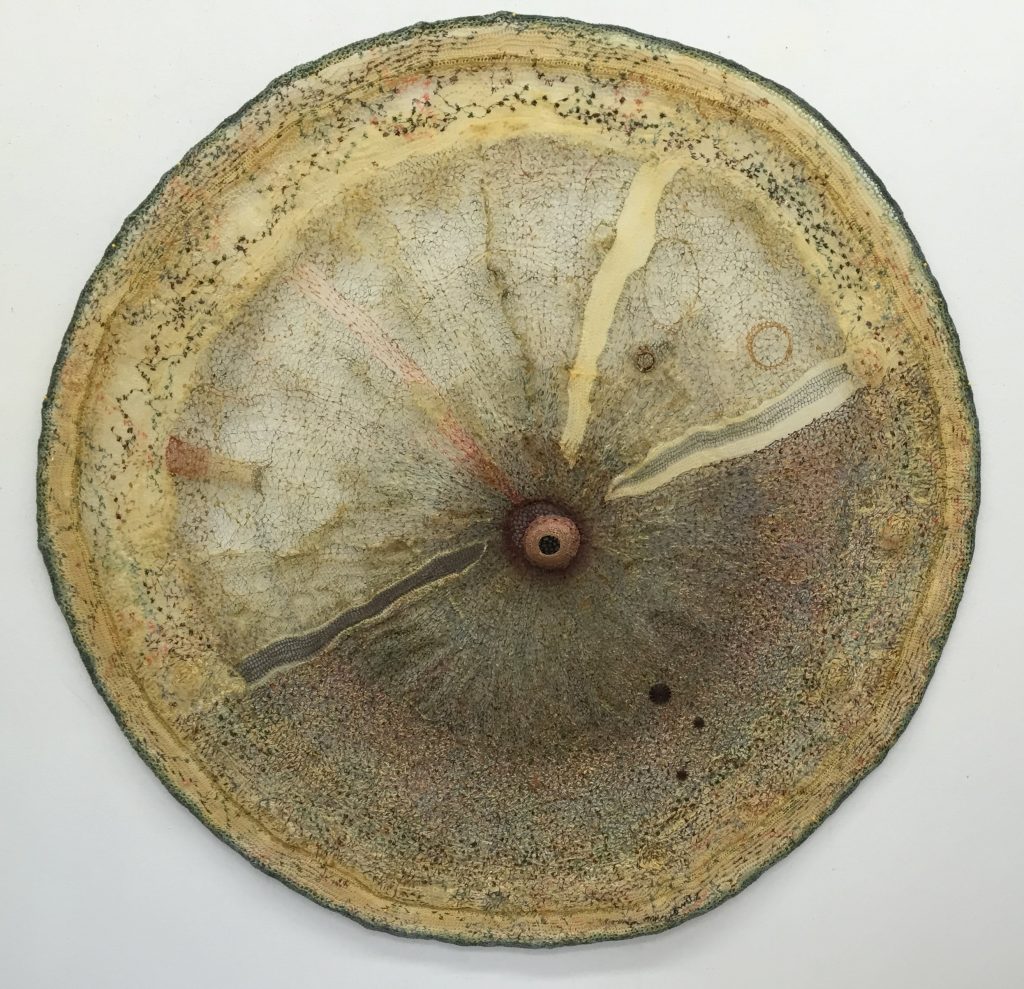
Journey’s End, 20 inches Dia
This was an important purchase for me. They also purchased another smaller stitched drawing called ” Lunar Landing” which at that time was a fairly new direction for me as it combined paper, crochet, collage and stitching.
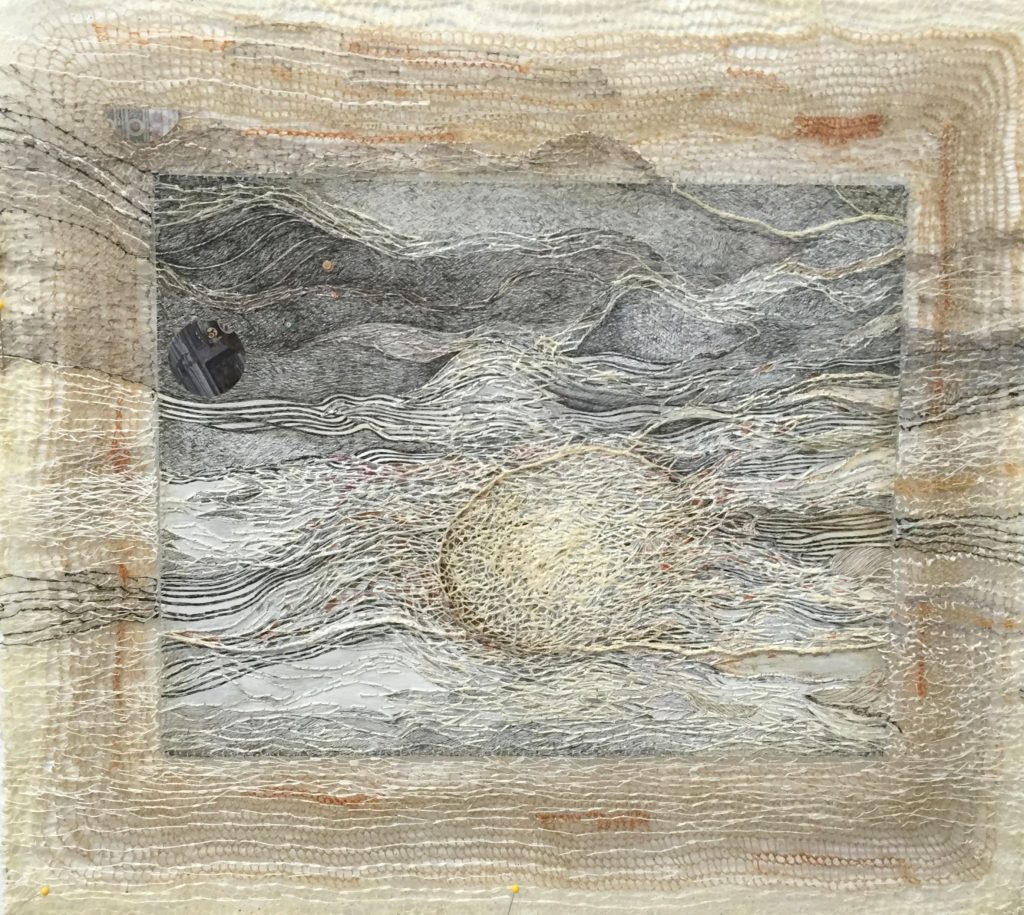
Lunar Landing, 2017, pen and ink, college and stitching
Even though I have had many museum purchases at much earlier dates that were exhibited in Museum shows, this was important as it was well publicized and has led to a public presentation at the Museum in late October 2019. It will be a discussion with a scholar regarding one of my other sculptures in their collection.
Expand on how you are drawn to the human form?
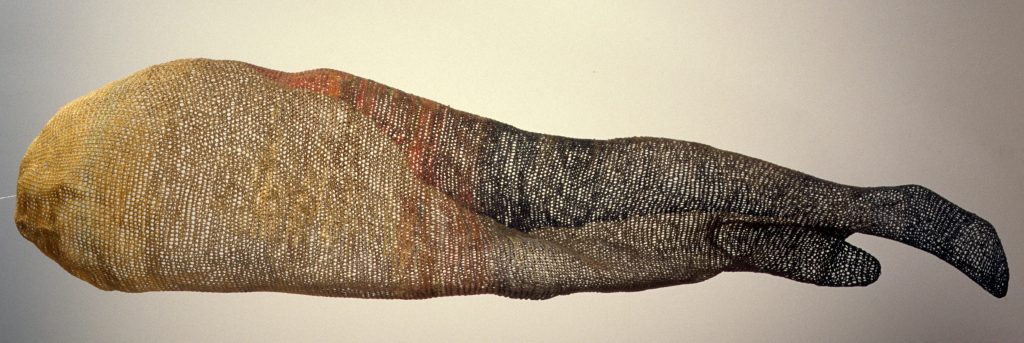
I am the Land, Denver Art Museum
As I exhausted the possibilities of the many enclosed vessel forms, I had created, I turned to my interest in the human form. My earliest drawings in pen and ink were always about the human form as well as the human condition. I now returned to the idea of using the figure in my sculptures which was a difficult transition as to being able to create them while making them transparent and at the same time structured. These where at once much larger and more complicated than the vessel forms. These veiled figurative sculptures were mostly created in the 1990’s to the mid 2000’s. I have also created multi -figure sculptures that illustrate the passage of time and other kinds of transitions, I call these installations sequential as I often use several juxtaposed and related figures together.
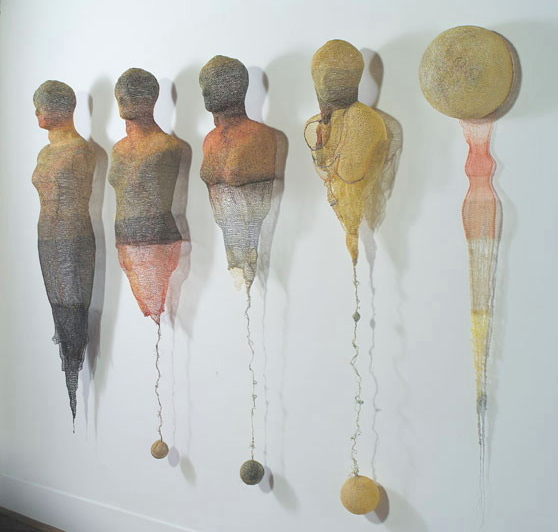
Body and Soul, Angle view
They are nearly identical figures that subtly change as does time and circumstance. “Goodbye Goddess” is such a sequential piece.
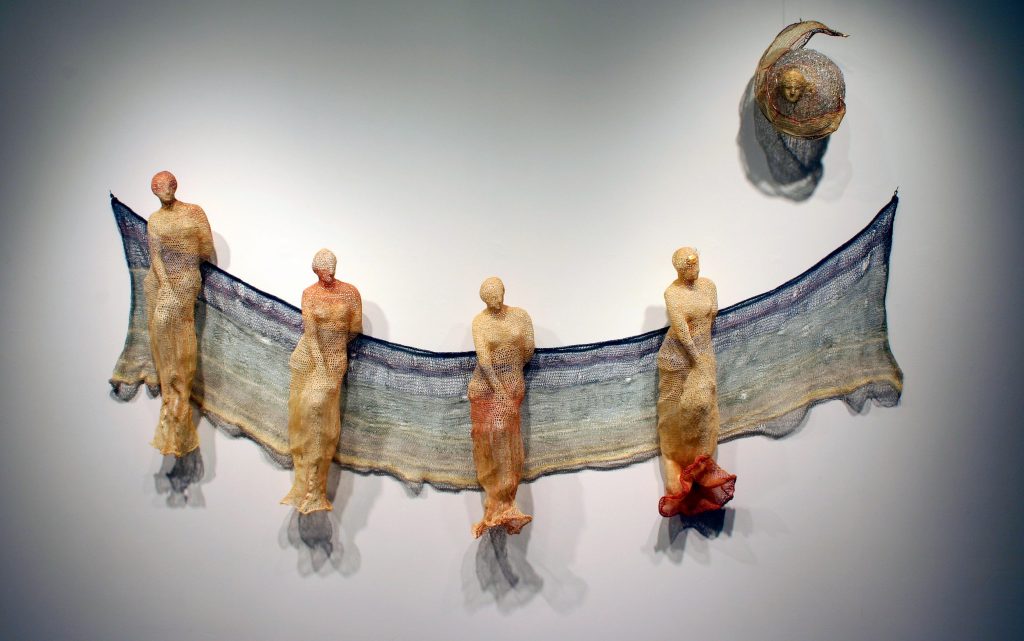
Goodbye Goddess
I still exhibit my figural sculptures and make new ones, but my work continues to change. In 2007, I started using modeling paste which has a plaster- like consistency to fill in the spaces of the fiber’s netting. This process creates a surface that focuses on and highlights the lines rather than the open spaces. I drew with the stitches, introducing a bas relief surface of concept, energy and movement. I often highlighted the lines with colors of paint, the concept of the figure was now bolder and darker in concept. My work continues to change and often reverts to previous methods and expressions.
Discuss ‘Goodbye Goddess’ the background to this exhibition as well as how it extended your work.
This is a well written accurate description of my sculpture by Kathleen Whitney a contributor to Sculpture Magazine, in a feature article of my work in Sculpture Magazine 2007.
Goodbye Goddess by Kathleen Whitney 2007
“Goodbye Goddess” is a series of four nearly identical smaller than life-size” Classical statuettes in a line that leads to a fifth circular shape hanging above them. Their contours are blurred, their features indistinct. Each is dressed in a Roman Style, draped in a toga-like outfit that falls well over the feet. These multiple figures slowly change in detail to become symbols of passage. In the fifth and final form, the same face that is on the figures in now distant and sky-bound, like a soul departing the body. To Minkowitz it is a piece that symbolizes the process of mortality or perhaps immortality through a series of subtle visual alterations in each figure.”
“Goodbye Goddess” is in the collection of the Wadsworth Athenaeum in Hartford CT and was recently exhibited in an impressive show called She: Images of Female Power from the Permanent Collection 2017. Being in this show with other major artists was certainly a plus for my career.
Discuss the relationship of your fine thread work with drawing.
Drawing continues to be important to me and I find the threads and wires I use mimic the patterns and movement, as well as the irregularities of my pen and ink drawings. My sculpture evolves into three dimensional drawings. The fibers placement creates a surface that focuses on and highlights the lines I draw with my stitches. These stitches introduce the concept of energy, message and movement. I often highlight these drawn lines with colors of paint. There is a crossover between the stitched line and the drawn line that contribute to my work that weaves the personal and universal together. I use fiber as if I were drawing and often the drawn line as if I were stitching. I find them to be interchangeable.
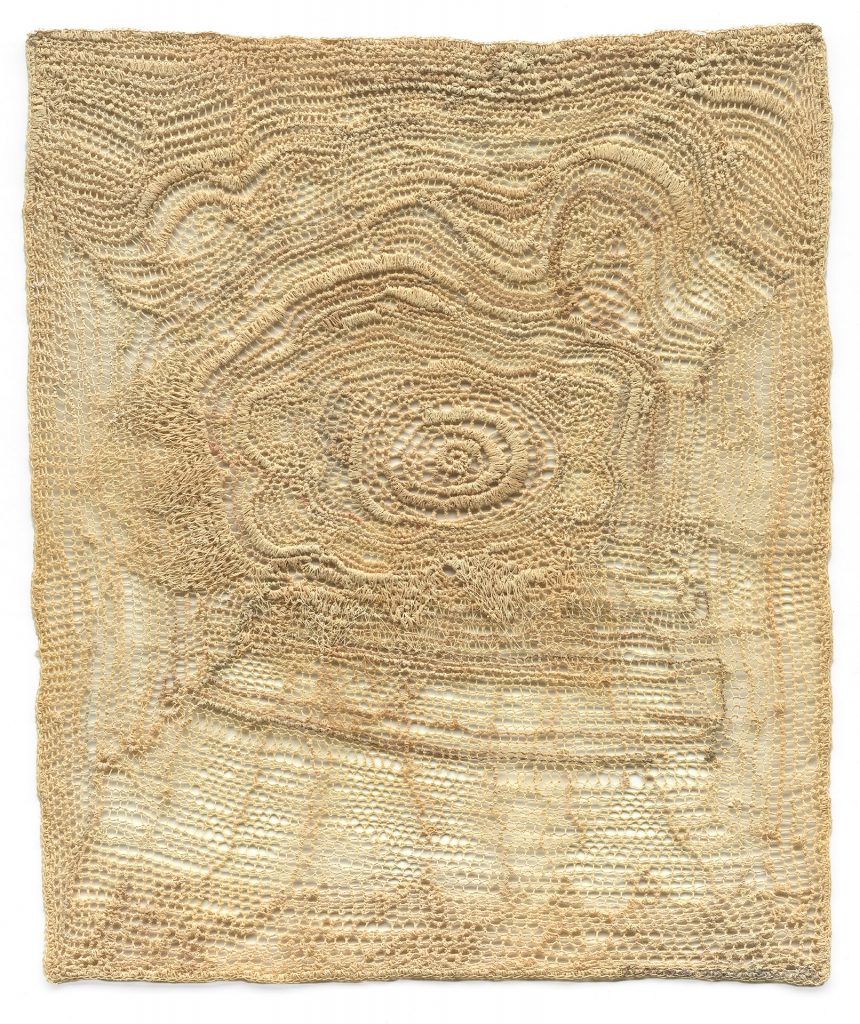
Detour, 2019, crochet and stitch drawing
You comment, “Fibre becomes art, when it is about why it is made rather than how it is made” expand on this comment in relations to textile craft.
A fiber work in my current opinion is craft when the reason for its making , although skilled and not without merit is when it is only about technical skill, emphasis on the use of many stitches and patterns without a clear message. It is a work of art when there is a powerful concept, fresh ideas, experimentation of materials to initiate reflection. I believe in risk taking and art that is unique to the artist. Art should push boundaries. At the same time there is really no simple definition as the art world and concepts of what art is keep changing.
Explain about your fibre drawings using Goodbye My Friend.
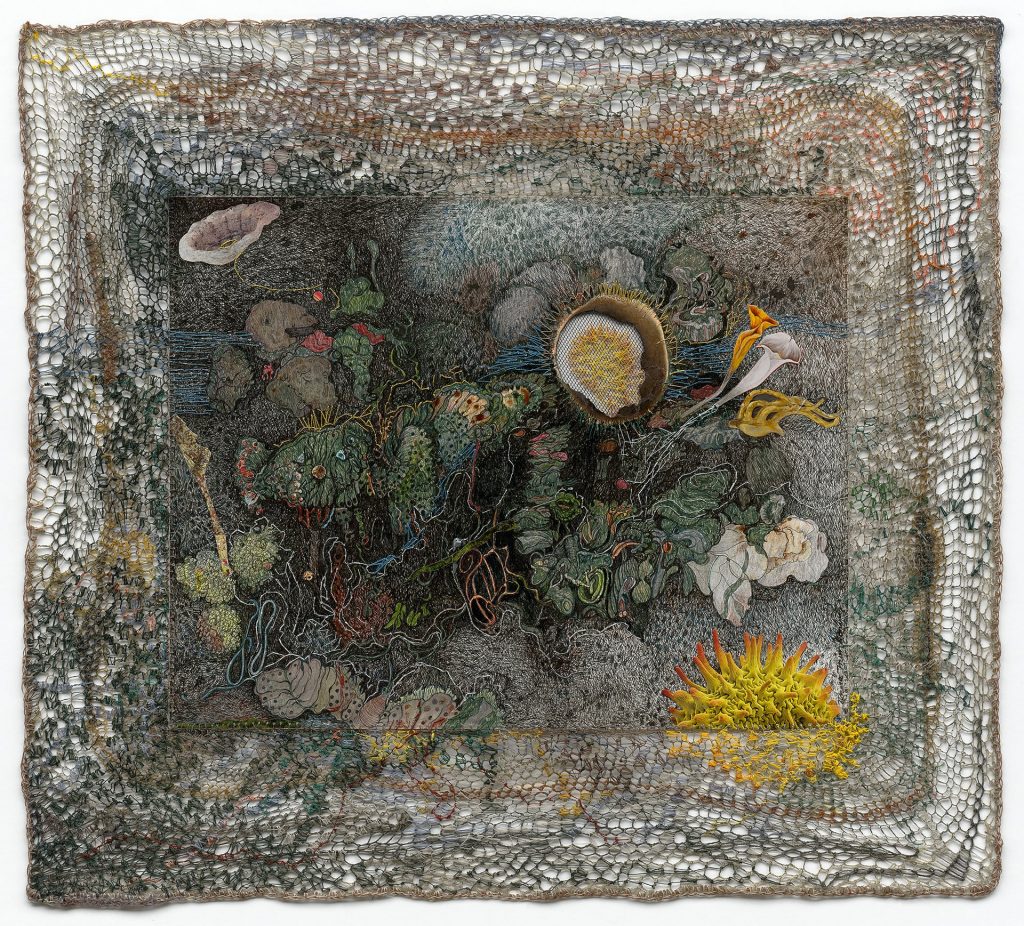
Goodbye My Friend, 2017, 13 x 20 inches, Fibre, paper, and ink, with college
Drawing continues to be important to me and I have recently embarked on a path to combine my drawings on paper with stitching, collage and crochet. ” Goodbye My Friend” was a very personal stitched drawing. It was originally drawn on paper and then combined with a border of crochet, collage and stitched fiber to create this magical image suggesting another place with a female profile in the middle searching or lost in reverie. At that time, I didn’t know what the title would be, but knew it had a sense of mystery and darkness. Shortly after its completion, not yet titled a close young friend took her own life. This hit me very hard and the drawing suggested my feelings of loss and regret. I titled the drawing “Goodbye My Friend”.
Take one piece and explain how it has influenced your current work?
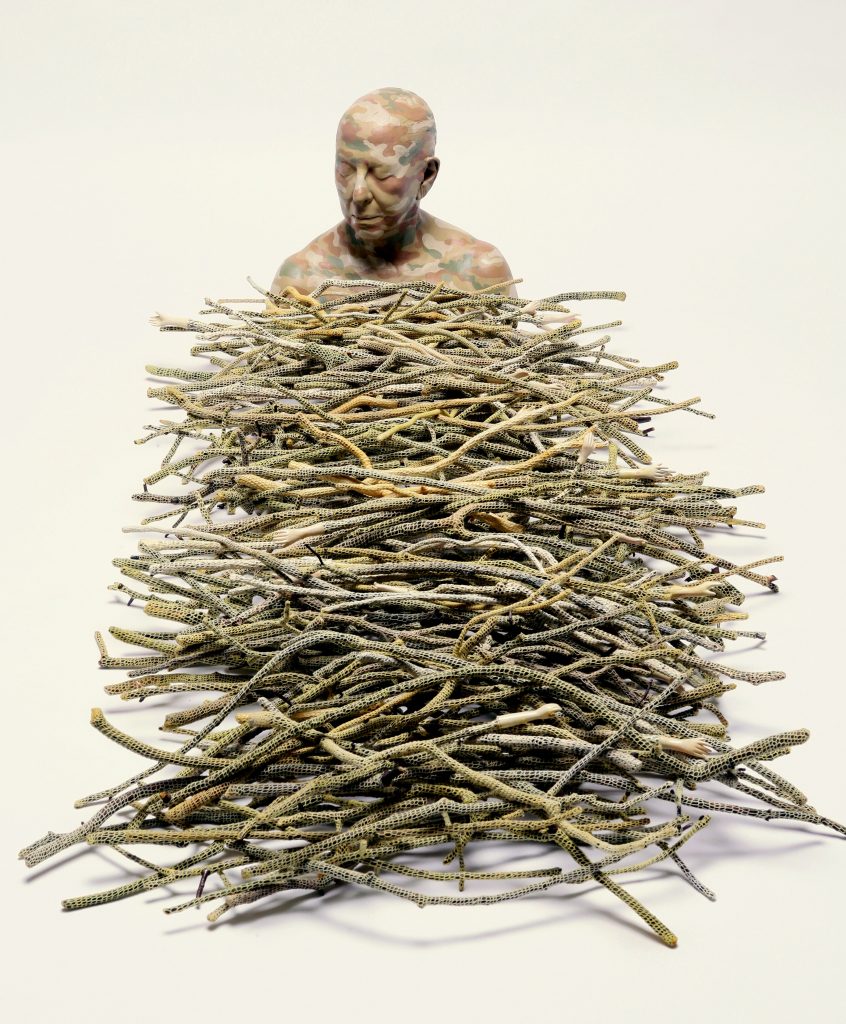
The Path, 2014
“The Path” 2014. I often dwell on the mysterious cycles of death and regeneration while focusing on the passage of time, containment and sequence. “The Path” is a self-portrait cast from my own head and painted in a camouflage pattern suggesting the act of hiding to avoid the inevitable path. The dead twigs which were once alive are symbols for bones. These bones are crocheted around to protect, caress, contain or perhaps entrap for eternity. I think rather than saying this piece influenced my work since it is current, I think it would be more appropriate to say my prior work influenced this latest major installation.
Contact:
Norma Minkowitz
norminky@optonline.net
Deborah Blakeley, Melbourne, Australia
Interview by Deborah Blakeley, August 2019
Think a colleague or friend could benefit from this interview?
Knowledge is one of the biggest assets in any business. So why not forward this on to your friends and colleagues so they too can start taking advantage of the insightful information the artist has given?
Other artists you may be interested in:


